IRIS International, Inc. (IRIS)
IRIS International, Inc. (IRIS)
IRIS International, Inc. (IRIS)
Create successful ePaper yourself
Turn your PDF publications into a flip-book with our unique Google optimized e-Paper software.
R E P R I N T E D F R O M S E P T E M B E R 2 0 , 2 0 1 0<br />
<strong>IRIS</strong> <strong>International</strong>, <strong>Inc</strong>. (<strong>IRIS</strong>)<br />
CESAR M. GARCIA has been a Director of <strong>IRIS</strong> <strong>International</strong> since November 2003 and<br />
Chairman of the company’s board since November 2007. He joined <strong>IRIS</strong> <strong>International</strong> in<br />
January 2002 as Executive Vice President; he was appointed President in June 2003 and<br />
Chief Executive Officer in November 2003. Mr. Garcia has more than 30 years of experience<br />
in the design, manufacturing and commercialization of medical devices. From 1998 through<br />
2001, Mr. Garcia was Senior Vice President, Operations and Program Management, for<br />
Cytometrics, <strong>Inc</strong>., an early-stage manufacturer of noninvasive photonics-based medical<br />
devices. From 1994 to 1998, he was Vice President of Operations and Engineering at<br />
Datascope Corp., a manufacturer of medical devices for interventional cardiology,<br />
anesthesiology and critical care monitoring. From 1974 to 1994, Mr. Garcia worked with<br />
Bayer Diagnostics (now Siemens Healthcare Diagnostics), where he held positions of<br />
increased responsibility, including General Manager of Technicon Electronics Corp., a<br />
subsidiary of Bayer USA, and Director of Worldwide Hematology Manufacturing and Cellular Diagnostics Research and<br />
Development. Mr. García earned a B.S. in industrial engineering, cum laude, at the University of Puerto Rico, and he<br />
received an Advanced Management Certificate from Pace University.<br />
SECTOR – HEALTH SERVICES<br />
TWST: What is <strong>IRIS</strong> <strong>International</strong>? Please give us an overview<br />
and take us through each of the company’s operating divisions.<br />
Mr. Garcia: <strong>IRIS</strong> <strong>International</strong> is a global leader in the automated<br />
segment of urinalysis. However, we are much more than a urinalysis<br />
company, as we have an integral business in sample processing and an<br />
emerging business in personalized medicine. Our present customers are<br />
hospital laboratories with medium to high test volumes and high-volume<br />
clinical reference laboratories, like LabCorp, Quest, Sonic Labs and others.<br />
As mentioned, we have three operating segments, including Iris Diagnostics,<br />
with a core business in urinalysis and an active research and development<br />
program in hematology. Our Iris Sample Processing is a global leader in<br />
bench-top, rapid-processing centrifuges and DNA workstations. We have<br />
an emerging business in personalized medicine now consisting of our<br />
recently acquired CLIA-certified molecular pathology laboratory and our Iris<br />
Molecular Diagnostics group, which we acquired in April 2006.<br />
TWST: Iris Diagnostics has been in the urinalysis testing<br />
market for over 25 years. Would you give us an example of the<br />
effectiveness of the Iris system?<br />
Mr. Garcia: Our Iris Diagnostics Division markets complete<br />
automation in urinalysis. One of the key differentiating factors in our<br />
fully automated iQ200 urinalysis platform is our proprietary technology<br />
in digital flow imaging, by which we identify and quantify microscopic<br />
sediments in urine. We actually image the urine, while most of the<br />
competing instruments use a scattergram to represent the distribution<br />
of the urine sediment particles. The users of competing systems have<br />
to interpret those results and when they cannot make a determination<br />
from those scattergrams, a slide needs to be manually reviewed under a<br />
microscope. The competing systems with scattergrams are fast, but they<br />
have manual review rates of approximately 30%. In our instruments, we<br />
capture and digitize the images of the microscopic particles in urine and<br />
other body fluids, and calculate the concentrations of up to 12 microscopic<br />
particles. Our customers can review and edit images in our system without<br />
a microscope, and that is truly automated urine microscopy. In a typical<br />
lab, our iQ200 system provides automation and workflow improvements<br />
that result in labor savings that typically justify their capital investment,<br />
with a payback of less than two years. This product superiority has made<br />
us the global leader in automated urinalysis.<br />
TWST: What is the market opportunity, both domestically<br />
and internationally? How is the system being marketed?<br />
Mr. Garcia: The urinalysis market is large, approaching $500<br />
million in annual sales worldwide. We define our addressable market as<br />
those customers that perform more than 40 urine microscopies per day.<br />
In urinalysis, there are two principal test modalities — urine chemistry<br />
and urine microscopy. Our core technology has traditionally been in<br />
the urine microscopy segment. That’s the area that we have focused on,<br />
although in September 2008, we launched our automated urine chemistry<br />
system, the iChemVELOCITY, in the international market. And when<br />
combined with the iQ200, it provides a fully integrated urinalysis<br />
workstation. In the U.S. we distribute an automated chemistry analyzer<br />
supplied by a Japanese manufacturer, which we will replace with the<br />
iChemVELOCITY upon FDA clearance, which is pending.<br />
C O M P A N Y I N T E R V I E W
C O M P A N Y I N T E R V I E W ——————— I R I S I N T E R N A T I O N A L , I N C .<br />
The total addressable market for urine microscopy is<br />
approximately 8,000 sites worldwide. Of those 8,000 sites, about 3,000<br />
sites are domestic and 5,000 sites are international. The domestic market<br />
for automated urine microscopy is approximately 50% penetrated, and<br />
the international market is about 70% penetrated. But it is important to<br />
mention that in the international market, we have been very successful<br />
in replacing many of our principal competitors’ instruments. It is worth<br />
mentioning that our principal competitor was in the market about five<br />
years before the release of our iQ200 in late 2003. We sell and support<br />
our domestic products through our direct commercial organization, and<br />
internationally we sell predominantly through distributors. But we now<br />
have direct sales in France, Germany, the U.K. and Puerto Rico.<br />
TWST: That said, would you tell us what current economic<br />
trends are impacting <strong>IRIS</strong> and its other businesses?<br />
Mr. Garcia: I think 2009 was a very difficult year for most<br />
diagnostics companies selling capital equipment. Even though historically<br />
the in vitro diagnostics segment has been very resilient to fluctuations<br />
in capital availability, in 2009 we experienced a significant reduction in<br />
instrument sales as a result of the global tightening in capital availability.<br />
Our consolidated revenue in 2009 was 3% lower than 2008, but we have<br />
recovered that reduction in 2010. In the first half of 2010, we experienced<br />
a 20% increase in revenue in comparison to the first half of 2009. In today’s<br />
economy, capital is more limited and more acquisition decisions are being<br />
made by hospital CFOs and their financial controllers. These executives<br />
use the financial payback as the metric to justify the investment decision.<br />
In the past, the decision-makers were lab directors, which are principally<br />
focused in clinical utility, not necessarily payback. With the shift in the<br />
decision-making process, we have modified our product presentation and<br />
the way we approach our customers, emphasizing the financial benefits<br />
of our products. Also the uncertainty in the global economies has made it<br />
more difficult to accurately forecast revenue and earnings due to currency<br />
fluctuations and capital availability.<br />
TWST: You became the CEO of <strong>IRIS</strong> in 2003. Would you<br />
describe how the company has changed since then and what you<br />
consider to be the top accomplishments?<br />
Mr. Garcia: <strong>IRIS</strong> is a completely different company since<br />
we released the new iQ200 platform in 2003, which coincided with my<br />
appointment as CEO of the company. At my arrival in 2002, I had to lead<br />
<strong>IRIS</strong> through a very challenging and exhausting product development<br />
schedule. By the time we released the iQ200, we had exhausted our cash<br />
and increased our debt to approximately $7 million. In the prior three<br />
years, between 2000 and 2002, we sold only an average of 50 legacy<br />
systems per year, and we had an installed base of some 450 instruments.<br />
Those systems were antiquated, expensive and difficult to service. Our<br />
international sales were only about 3% of the revenue. The management<br />
team needed to be upgraded in order to effectively compete in the industry.<br />
The manufacturing facility was suboptimal. Our reputation in the market<br />
was not the best because of the low reliability of the legacy systems. With<br />
the launch of the iQ200, we became a significant player in urinalysis. Since<br />
2005 we have consistently sold between 400 and 500 iQ200 systems per<br />
year, in comparison to the 50 legacy systems per year that we sold prior<br />
to the release of the iQ200. We now have an installed base of more than<br />
2,800 iQ200 systems worldwide, with recurring consumables and service<br />
revenue representing more than 50% of our total revenue.<br />
Our revenue has grown to more than $100 million today<br />
from $28 million in 2002. We are now debt-free and have more than<br />
$30 million in cash, even after investing more than $50 million in new<br />
technology and acquisitions over the last five years. I’m pleased to report<br />
that we have just begun to see the results of these investment initiatives<br />
with increasing sales of the iChemVELOCITY chemistry analyzer and<br />
associated consumables. We continue our efforts to design, build and<br />
commercialize highly differentiated product solutions with significant<br />
high-margin recurring consumables. We are proud that a company of<br />
our modest size has been successful in competing with much larger<br />
companies. We have attained a privileged position in the market place,<br />
both in terms of product placements and with awards recognizing the<br />
excellent service that we provide to our customers. The increased clinical<br />
utility and workflow experienced by our customers due to our instruments<br />
are also key differentiators.<br />
TWST: <strong>IRIS</strong> recently acquired the business of its overseas<br />
distributors in the U.K. and Germany. Would you explain the<br />
strategy behind this move?<br />
Mr. Garcia: This is one of the major initiatives we undertook<br />
in 2010, and I would like to take this opportunity to clarify why this is a<br />
very strategic and important step in the execution of our growth plans.<br />
The acquisition of those distributors’ business was necessary to lay down<br />
the foundation for international sales of new products expected from our<br />
core in vitro diagnostics business, as well as new products coming from<br />
“With the launch of the iQ200, we became a significant player in urinalysis. Since 2005<br />
we have consistently sold between 400 and 500 iQ200 systems per year, in comparison<br />
to the 50 legacy systems per year that we sold prior to the release of the iQ200.”<br />
our Molecular Diagnostics group, and for <strong>IRIS</strong> to take direct control<br />
of our destiny in the international market. The massive consolidation<br />
of IVD manufacturers between 2005 and 2007 resulted in significantly<br />
reduced product portfolios for many international distributors, and this<br />
was a catalyst for us to acquire the distributors’ business in certain<br />
underperforming European territories. For example, since the initiation<br />
of our direct commercial operation in France in 2005, we have sold more<br />
than 130 of our iQ200 instruments. In comparison, during approximately<br />
the same time frame, our distributors in the U.K. and Germany sold only<br />
about 60 iQ200 analyzers. Although the timing of the acquisition was not<br />
ideal, we could not pass on the opportunity. We bought the distributors’<br />
asset at cost, with the understanding that we would need to invest<br />
more than $2.5 million to reinvigorate those markets in 2010 in order<br />
to establish an excellent international organization and infrastructure,<br />
which should result in significantly greater sales of our products in the<br />
international marketplace and with greater profit margins, as well as<br />
provide a foundation from which to launch the new products that we are<br />
planning over the next five years. So with this implementation, we will<br />
sell direct in most of the major European countries with the exception of<br />
Italy and Spain.<br />
TWST: The company recently acquired AlliedPath, a<br />
private CLIA-certified lab that’s focused on oncology and molecular<br />
diagnostics. What did that acquisition add to <strong>IRIS</strong>? How did it factor<br />
into the company’s overall growth strategy?<br />
Mr. Garcia: Let me step back for a moment. In 2006 we acquired<br />
our NADiA ultra-sensitive nucleic acid detection immunoassay technology<br />
platform to enable the early detection of residual diseases, such as cancer<br />
relapse and HIV breakthrough. Since then, we have invested some $30<br />
million in funding this business and the related R&D initiatives in developing<br />
our NADiA product line. We acquired AlliedPath in July 2010 primarily to
C O M P A N Y I N T E R V I E W ——————— I R I S I N T E R N A T I O N A L , I N C .<br />
provide a direct commercial channel for accelerating our NADiA platform.<br />
The first test we have developed under the NADiA platform is NADiA<br />
ProsVue, our prostate cancer prognostic test, which is currently under<br />
FDA 501(k) review. Our CLIA laboratory acquisition not only enables the<br />
distribution channel for NADiA ProsVue, which we plan to launch as soon as<br />
it receives FDA clearance, but it also provides a commercial platform to sell<br />
most of the other NADiA-based products we are developing, including the<br />
NADiA HIV viral load test, a NADiA test for breast cancer and other NADiA<br />
applications. In addition, we believe there is an opportunity to license our<br />
NADiA technology in order to generate higher earnings, and increase the<br />
acceptance and utilization of the technology.<br />
This strategic acquisition positions <strong>IRIS</strong> with a state-of-the-art,<br />
fully equipped, high-complexity, CLIA-certified molecular pathology<br />
laboratory, offering differentiated, high-value molecular diagnostics tests<br />
and services. The laboratory currently offers molecular mutation testing<br />
for solid tumors, including lung and colorectal cancer, and is expected<br />
to add breast cancer by the end of the year. In addition, <strong>IRIS</strong> is planning<br />
to add flow cytometry for detection and monitoring of leukemia and<br />
lymphoma, and will add FISH testing to augment the laboratory’s test<br />
menu. We believe the molecular pathology and personalized medicine<br />
market is growing very rapidly within the esoteric laboratory services<br />
and tests segment, a market which, in the U.S., is expected to grow to $21<br />
billion annually by 2015, from $11 billion in 2009.<br />
It is our intention to strengthen the relationship between our<br />
molecular diagnostics development group and our CLIA lab to accelerate<br />
the release of new NADiA applications and to build a relationship with<br />
pathologists, urologists and other health care professionals in order<br />
to deliver personalized medicine solutions. We also believe the CLIA<br />
laboratory, in addition to being an anticipated source of additional revenue<br />
and earnings, allows us to better control critical commercial decisions, such<br />
as a value-based pricing strategy, marketing, communication programs and<br />
other commercial priorities. We expect to gain access to patient samples<br />
that are difficult to obtain otherwise. So it will help us accelerate product<br />
development and obviously will keep us closest to the clinical decisionmakers<br />
and the clinical users, which is something that is very important in<br />
the early stages of launching a product platform like NADiA.<br />
I believe the acquisition is very strategic for these and many<br />
other reasons. While this acquisition will be dilutive in 2010 and 2011,<br />
we do expect to reach breakeven in 2012. The gross margins for this<br />
new business are expected to range between 70% and 80%. We have<br />
hired an experienced and highly competent management team to run this<br />
operation, and we are confident our targets are achievable.<br />
TWST: Is growth basically in-house generated, or would<br />
you look at strategic opportunities, i.e., M&A, personnel, products<br />
or alliances?<br />
Mr. Garcia: I think that mergers and acquisitions are important<br />
for us. I think that we can benefit significantly by adding more products<br />
through our existing commercial organization and increasing our scale.<br />
We have an award-winning customer service infrastructure with direct<br />
field service and support that can synergistically benefit from adding<br />
more products to our current offering. However, we do not want to<br />
become a portfolio company with products that are not directly related.<br />
We want to maintain the focus in image morphology with applications<br />
in urinalysis, hematology and personalized medicine. We also have a<br />
Sample Processing division with the bandwidth to absorb more product<br />
lines. We are looking for product lines or companies that would bring<br />
incremental revenue and earnings, and potentially enable us to get our<br />
product pipeline to the market faster. With that said, we are only focusing<br />
on accretive acquisitions at this point in time.<br />
TWST: Turning to your top management and internal<br />
operations, do you have any plans to change any of these areas? Are<br />
there perhaps specific needs you will address over the next year or so?<br />
Mr. Garcia: Over the last year, we added senior management<br />
talent to address some of our weaknesses. Late in 2009, we hired a new<br />
Vice President of Corporate Quality and Regulatory Affairs and a new<br />
Vice President of Research and Development for the Iris Diagnostics<br />
division. We restructured the sales management team, both domestic and<br />
international, adding a Vice President of Sales for America and several<br />
country managers in support of our direct sales initiatives abroad. Our<br />
restructuring of the sales organization is intended to put more emphasis<br />
in Europe and to cope with the changing economic environment. This<br />
increase in sales staff is partially responsible for the significant increase<br />
in sales we have achieved in the first half of 2010.<br />
Most recently, with the acquisition of our molecular pathology<br />
laboratory, we hired a President for that division, and as a part of that<br />
acquisition, one of the founders of AlliedPath joined our management<br />
“It is our intention to strengthen the relationship between our molecular diagnostics<br />
development group and our CLIA lab to accelerate the release of new NADiA applications<br />
and to build a relationship with pathologists, urologists and other health care<br />
professionals in order to deliver personalized medicine solutions.”<br />
team as Chief Medical Officer, a newly created position at <strong>IRIS</strong>. Both of<br />
these executives will have a very significant role in the launch of our new<br />
business in personalized medicine. I am very proud of the quality of the<br />
management team. We’re a $100 million company with a management<br />
team that comes from very large in vitro diagnostics companies and is<br />
committed to delivering our growth plans. We all have experience in<br />
multibillion-dollar global companies. We have revamped our senior<br />
management team, as it was necessary to achieve more predictable<br />
outcomes in terms of product launches and financial performance. I am<br />
confident we now have the breadth and depth in the management team to<br />
more consistently meet our commitments.<br />
TWST: Last month you announced the highest-revenue<br />
quarter in the company’s history, with second-quarter revenue up<br />
19% from the same period last year. What made this year’s second<br />
quarter such a success?<br />
Mr. Garcia: We have been working very hard in increasing<br />
our sales funnel globally, and in streamlining the sales organization<br />
and enhancing our iChemVELOCITY. I think that we’ve fine-tuned the<br />
sales message so we not only talk about the clinical advantages of the<br />
instrument, but also talk more about the financial benefits generated by<br />
our products. I believe there has been a recovery in the IVD market, where<br />
the hospital and clinical reference lab customers are more confident about<br />
the general economic outlook, something that has definitely helped us<br />
in achieving record revenues during the last nine months. In addition to<br />
that, we have had very strong consumable sales over the same period.<br />
In 2009 we worked very hard in relaunching our iChemVELOCITY<br />
urine chemistry analyzer in the international market, and it has begun<br />
to produce results in 2010 by generating incremental consumables and<br />
absorbing excess capacity in our strip manufacturing plant in Marburg,<br />
Germany. Also in the first half of 2010, our domestic sales were much
C OC O M P A N Y Y I NIT NE RTV EI ERW V ——————— I E W ——————— I R I S I N TC EOR NM APT IA O N AY L , , I N C .<br />
C .<br />
better than last year, part of which is related to the availability of capital,<br />
and we have been more effective in getting some of that capital.<br />
TWST: What was the motive behind <strong>IRIS</strong>’ recently<br />
approved $10 million share repurchase program? Why do you<br />
consider a share buyback program to be a good use of capital at<br />
this time?<br />
Mr. Garcia: We decided to implement a stock buyback<br />
program because we believe the intrinsic value of <strong>IRIS</strong> at this time is<br />
much greater than what is reflected in the current stock price. We wanted<br />
to send the message that both the management and the board of directors<br />
are confident that we can execute on the plans that we have ahead. We<br />
believe the recent decline in our share price is a reflection of the delays<br />
in attaining FDA clearance of our iChemVELOCITY and the NADiA<br />
ProsVue, and believe our market capitalization should improve as these<br />
products receive anticipated approvals in the near future. The other<br />
reasons for the recent stock performance relates to our decision to reinvest<br />
cash from operations to finance significant investments, which are<br />
expected to be very good for the long term but are dilutive in 2010 and<br />
2011. For example, this year we are investing $2.5 million in regrowing<br />
the international distribution organization. In addition, we are investing<br />
$5 million in molecular diagnostics and obviously with our recent<br />
acquisition of AlliedPath, where we invested an initial $4.7 million in<br />
cash for the acquisition, and committed to invest another $2.5 to $3.0<br />
million in the commercial launch of the new CLIA laboratory.<br />
We have a core business that is producing significant earnings,<br />
and we opted to reinvest those earnings in growth that we could not achieve<br />
otherwise. I believe that is the right move at this point in time. <strong>IRIS</strong> has<br />
been sitting on a significant amount of cash without putting that cash to use,<br />
and I do not believe that serves the shareholders in the long run.<br />
TWST: In your discussions with the investment community,<br />
are there any recurring questions or misperceptions? Does the<br />
investment community understand the <strong>IRIS</strong> story?<br />
Mr. Garcia: I think the investment community does not fully<br />
understand our strategy, and they are very concerned with our products<br />
attaining regulatory clearance. We are optimistic about attaining clearance<br />
on these new products soon. One of the recurring questions relates to the<br />
release of the new products and the attainment of FDA clearance for the<br />
iChemVELOCITY and the NADiA ProsVue. There is much concern with<br />
the strict requirements imposed by the FDA, which are beyond the control<br />
of the company’s management. The regulatory environments have changed<br />
dramatically over the last two years. In the past, our products were cleared<br />
in a timely manner, but more recently the FDA has become much stricter<br />
and they have heightened the clearance requirements. The FDA is in the<br />
process of redefining the 510(k) process, and we have been reacting to<br />
their changes in policy, something that has affected many manufacturers’<br />
ability to get their products cleared under 510(k)s. That’s one of the biggest<br />
concerns. Myself, as CEO, the board of directors and the management team<br />
share some of those same concerns, but we are addressing this methodically<br />
and consistently, as we did with our recent success in attaining clearance<br />
for our synovial fluid 510(k) application.<br />
The other recurring theme is the rationale for our investment<br />
in molecular diagnostics and personalized medicine. Some shareholders<br />
feel that we should remain in the core morphology business only. We<br />
believe that the company has greater potential by diversifying into<br />
personalized medicine and diversifying the core urinalysis product line<br />
into hematology. We have been running the company for the long run.<br />
With that said, we have enough in our product platform at this time, and<br />
we do not intend to make any additional technology acquisitions in the<br />
near future. We are now placing much more emphasis on shareholder<br />
return because most of the recent strategic initiatives have been dilutive,<br />
and we want to demonstrate that the investment in these new product<br />
initiatives are commercially progressing and beginning to create value<br />
for our customers and shareholders.<br />
We have been very successful in generating significant<br />
incremental revenue over the last five years. The company’s compounded<br />
annual growth rate of revenue has been more than 18% since 2002. If you<br />
exclude the investment in molecular diagnostics and the laboratory, the<br />
compounded annual growth rate of earnings since 2002 on an adjusted<br />
basis is approximately 35%. The management team has proven that we<br />
can execute commercially, and we expect the investment in our product<br />
pipeline will prove to be successful through future earnings generation.<br />
The other concern that the shareholders have is whether we are<br />
going to continue the trend of dilutive acquisitions, and the answer is no.<br />
We are looking for product opportunities that can synergistically benefit<br />
from the infrastructure we have established, so we can gain financial<br />
leverage. Our general concept is growth at a reasonable price. That is<br />
what we are planning to achieve over the next few years.<br />
TWST: Are those the key metrics for investors to focus on?<br />
Mr. Garcia: I think the key metrics are, number one,<br />
maintaining the momentum in the sales of our existing core product.<br />
We have been successful in recovering our sales momentum in 2010<br />
versus 2009. Number two is getting clearance for iChemVELOCITY and<br />
NADiA ProsVue. Those two product clearances are very important. Our<br />
third priority is to complete an integrated prototype for the new imagebased<br />
hematology analyzer and accelerating the development of our<br />
next-generation urinalysis system in 2011. Finally, on the personalized<br />
medicine side, it is our objective to achieve our revenue and growth<br />
targets for the laboratory in 2011 and achieve breakeven in 2012.<br />
TWST: In conclusion, what is your summary statement?<br />
What should compel investors to include <strong>IRIS</strong> as a part of their<br />
current portfolios and longer-term investment strategies?<br />
Mr. Garcia: <strong>IRIS</strong> is a company with a track record in growth<br />
and innovation. We have grown the company from $28 million in revenue<br />
to over $100 million between 2002 and 2010, and we are confident that<br />
we can focus on earnings generation now that our technology acquisitions<br />
are behind us. We have the management team to execute on our future<br />
plans. The company has a solid core business that continues to generate<br />
revenues and earnings, and an emerging business in personalized<br />
medicine and molecular diagnostics. I believe the current valuation of<br />
the company does not reflect the value of our new product pipeline under<br />
development. Our plan is to change that by attaining clearance on our<br />
pending regulatory applications and consistently achieving our strategic<br />
and financial milestones.<br />
TWST: Thank you. (KL)<br />
CESAR M. GARCIA<br />
Chairman & Director<br />
<strong>IRIS</strong> <strong>International</strong>, <strong>Inc</strong>.<br />
9172 Eton Avenue<br />
Chatsworth, CA 91311<br />
(818) 709-1244<br />
(818) 700-9661 — FAX<br />
www.proiris.com<br />
© 2010 The Wall Street Transcript, 48 West 37th Street, NYC 10 018<br />
Tel: (212) 952-740 0 • Fax: (212) 668-9842 • Website: www.twst.com












